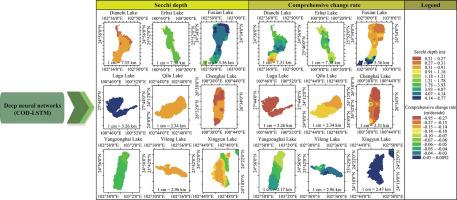International Journal of Applied Earth Observation and Geoinformation ( IF 7.5 ) Pub Date : 2021-04-21 , DOI: 10.1016/j.jag.2021.102344 Zhenyu Yu , Kun Yang , Yi Luo , Yulian Yang

|
Secchi depth (SD) can directly reflect the state of lake water quality, and it is the key to control and improve the lake environment at mastering long-term and large-scale. In this research, deep neural networks algorithm was used to derive SD of 9 major plateau lakes in Yunnan Province from January 2001 to December 2018 based on MODIS remote sensing images, and explored the spatial-temporal variation characteristics with SD by geospatial analysis. The results showed that: (1) The inversion model proposed in this paper had a good performance (RMSE = 0.1359, MAE = 0.1134), which can objectively reflect SD status in the lake. (2) The temporal variation characteristics showed that SD of all lakes has a downward trend with a mean comprehensive change rate of −0.25 m/decade. (3) The spatial variation characteristics showed that the region of higher SD has a larger decline rate, and the trend in the region with lower SD was relatively stable. SD near urban and residential areas was relatively low, and declined fast. (4) Human activities would become an important factor to affect SD changes in the plateau lakes of Yunnan Province, and it was also the main factor causing lake pollution in the Yunnan-Guizhou Plateau.
中文翻译:

塞奇深度反演及其时空变化分析-以云南省九个高原湖泊为例
Secchi深度(SD)可以直接反映湖泊水质状况,这是长期和大规模掌握和控制和改善湖泊环境的关键。本研究利用深度神经网络算法,基于MODIS遥感影像,从2001年1月至2018年12月,推导了云南省9个主要高原湖泊的SD,并通过地理空间分析探索了SD的时空变化特征。结果表明:(1)本文提出的反演模型具有较好的性能(RMSE = 0.1359,MAE = 0.1134),可以客观地反映湖泊的SD状态。(2)时间变化特征表明,所有湖泊的SD均呈下降趋势,平均综合变化率为-0.25 m /十年。(3)空间变化特征表明,SD较高的区域下降率较大,SD较低的区域趋势相对稳定。城市和居民区附近的SD相对较低,并且下降很快。(4)人类活动将成为影响云南高原湖泊水质变化的重要因素,也是造成云贵高原湖泊污染的主要因素。


























 京公网安备 11010802027423号
京公网安备 11010802027423号